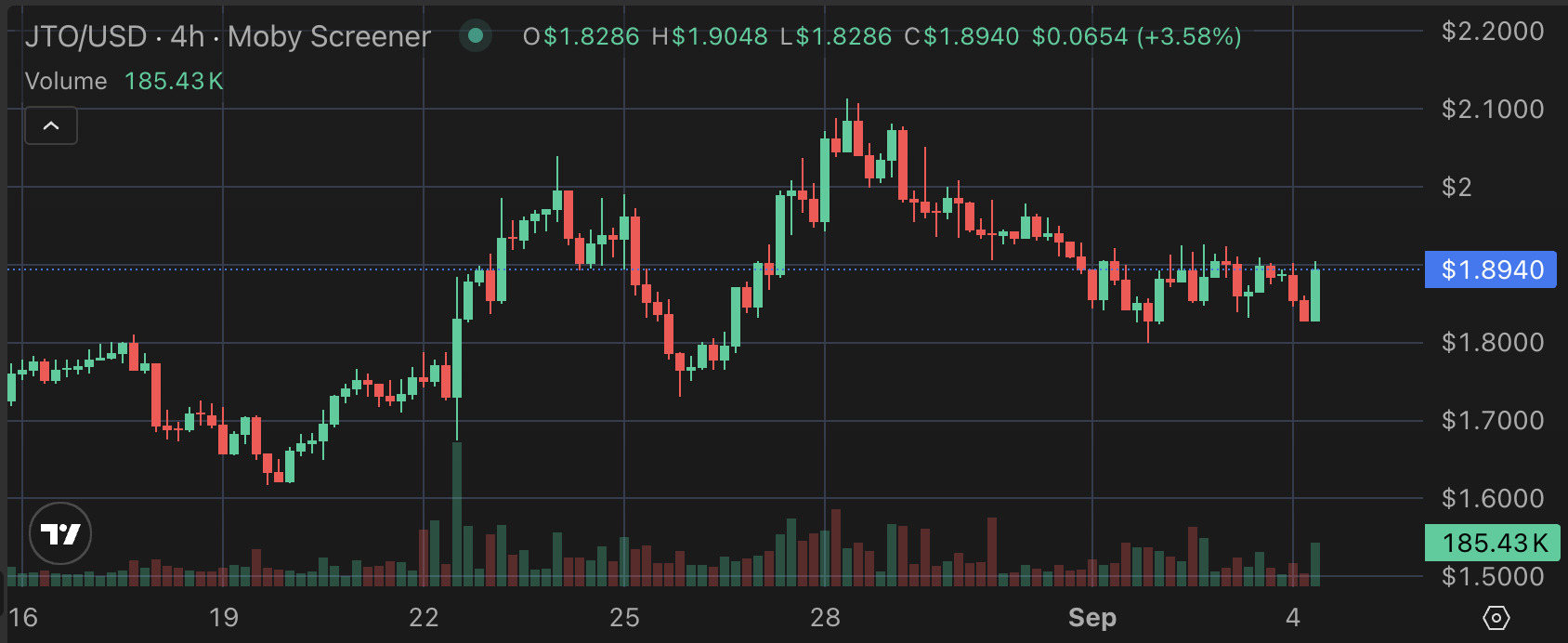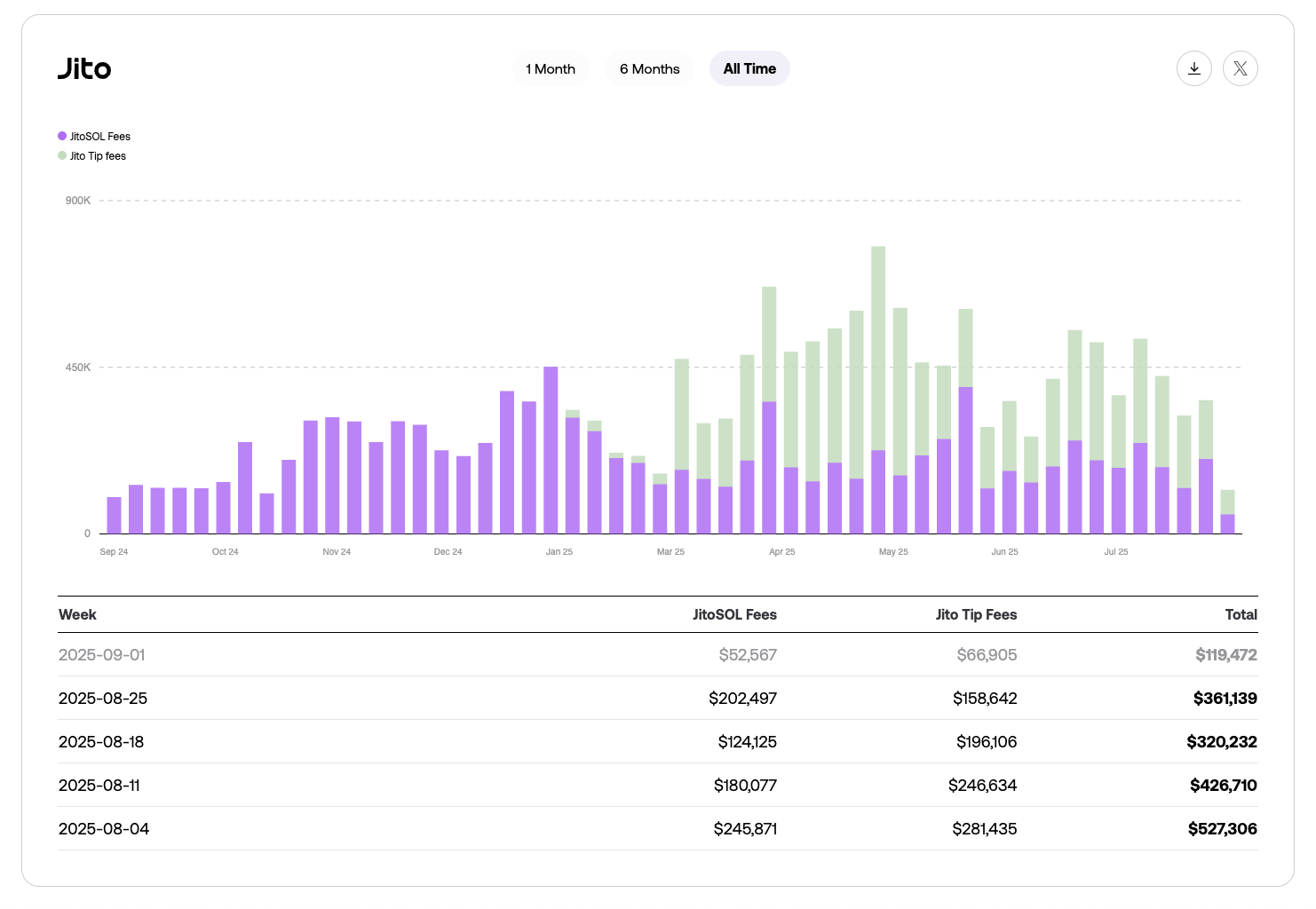
Jito DAO aprueba una propuesta para duplicar sus ingresos - ¿Qué significa esto para $JTO?
Se avecinan cambios en las finanzas de Jito - ¿Está $JTO infravalorado?
- Publicado:
- Editado:
Jito Labs es, en muchos sentidos, la sala de máquinas de Solana. Con el 96% de la participación en la red ejecutando el cliente validador Jito-Solana y el dominio de $jitoSOL’en el sector LST, Jito ejerce una influencia significativa en todo el ecosistema.
A pesar de la posición de poder de Jito’s, Solana es, de alguna manera, la sala de máquinas.
A pesar de la posición de poder de Jito, poco del éxito del protocolo se ha transmitido a su token nativo, $JTO. Sin embargo, una serie de recientes propuestas de gobernanza podrían estar a punto de cambiar esta situación.
¿Cuáles son los cambios que se avecinan en las finanzas de Jito’s, y qué podrían significar para $JTO y sus tenedores?
.
La aprobación de JID-24 duplica la asignación de ingresos de DAO
El 4 de septiembre, los tenedores de $JTO votaron unánimemente a favor de JID-24, una propuesta de gobernanza que buscaba dirigir el motor de bloques y las futuras cuotas del BAM a la Tesorería del DAO de Jito.
Antes de la propuesta, el 6% de las comisiones del Jito Block Engine se dividían entre Jito Labs y el Jito DAO. Con el JID-24 aprobado, Jito Labs ha cedido su parte al Jito DAO, junto con las futuras comisiones generadas a través de BAM.
El cambio duplica efectivamente la asignación de Jito DAO’de los ingresos del protocolo, que se espera que aumente aún más una vez que BAM entre en funcionamiento. A pesar del catalizador, los mercados parecen no darse por enterados, con $JTO bajando un 8,7% en los últimos 7 días.

$JTO’s rendimiento decepcionante en la cara de duplicar la acumulación de valor token es quizás debido a la mecánica de flujo de valor del activo’s vaga. Mientras que muchos protocolos a través de Solana han esbozado modelos de recompra claros y programáticos, Jito DAO está manejando las cosas de manera más estratégica.
En junio, Jito DAO aprobó una propuesta de gobierno (JID-17) que permitía la formación de una Sub-DAO de Criptoeconomía, o CSD. El CSD de Jito DAO recibió inicialmente $7,5M en $jitoSOL y 5M de tokens $JTO para optimizar la acumulación de valor $JTO a través de métodos como recompras, subsidio de rendimiento y bóvedas de cambio de tarifas.
Como resultado de la aprobación de la JID-24, los ingresos asignados a la tesorería del Jito DAO a través de las tasas del motor de bloques y las tasas de futuros BAM fluirán principalmente hacia los mecanismos estratégicos de acumulación de valor del CSD.
¿Qué significa esto para $JTO?
Aunque el CSD no ha esbozado con precisión cómo pretende utilizar la asignación de los ingresos del protocolo de Jito DAO, no se puede negar que la duplicación de los ingresos de la tesorería debería impulsar las estrategias de acumulación de valor de $JTO.

En agosto, Jito DAO generó 1,61M$ en ingresos. Tras la aprobación de JID-24’y la asignación por parte de Jito Labs de su cuota del 3% de las comisiones del motor de bloques a la DAO, podemos esperar que esta cifra aumente drásticamente.
Además, el CEO de Jito Labs, Lucas Bruder, estima que los plugins de BAM podrían aportar 15 millones de dólares adicionales al año en ingresos del DAO.

Según Datos de Artemis, la relación actual entre capital de mercado e ingresos de Jito se sitúa en 30,5. Aunque se trata de una cifra respetable por derecho propio, sigue siendo inferior a la de otros protocolos de Solana como pump.fun (2,6), Jupiter (4,2) y Raydium (19,6).
Mientras tanto, $jitoSOL podría estar a punto de atraer entradas institucionales a una escala sísmica. En la actualidad, $jitoSOL es la LST elegida por REX-Osprey’s Solana Staking ETF, el único ETF de $SOL que cotiza en Wall Street. VanEck también está ansioso por unirse al juego del liquid-staking, habiendo presentado un formulario de registro S-1 para su ETF $jitoSOL el 22 de agosto.
En última instancia, el crecimiento de $JTO’todavía se ve obstaculizado por vagos mecanismos de acumulación de valor. Mientras que la mayoría de las aplicaciones DeFi de Solana han optado por recompras programáticas, el crecimiento de $JTO está ligado a los caprichos y estrategias del CSD de la DAO.
Más información sobre SolanaFloor
Los creadores adoran las nuevas recompensas dinámicas de pump.fun
SolanaFloor
Solana’s RWA Arms Race


